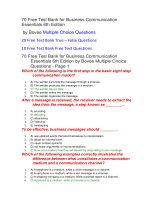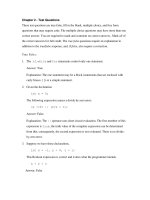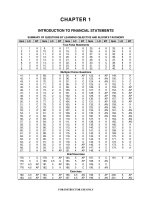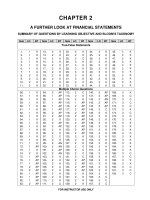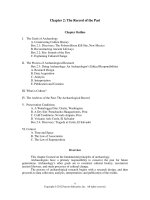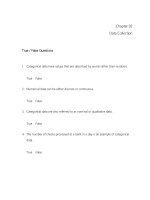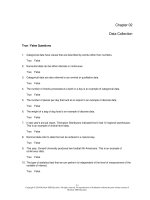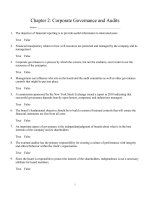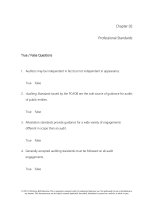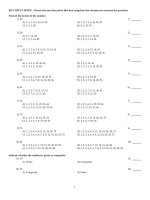Business communication essentials 5th edition bovee test bank
Bạn đang xem bản rút gọn của tài liệu. Xem và tải ngay bản đầy đủ của tài liệu tại đây (367.25 KB, 44 trang )
Business Communication Essentials, 5e (Bovee)
Chapter 2 Mastering Team Skills and Interpersonal Communication
MULTIPLE CHOICE. Choose the one alternative that best completes the statement or answers
the question.
1) Teams are at the core of ________ management, which is the effort to involve employees in
the company's decision-making process.
A) change
B) participative
C) top-down
D) personnel
E) process
Answer: B
Explanation: B) Teams are often at the core of participative management, the effort to involve
employees in the company's decision making.
Page Ref: 29
Classification: Conceptual
AACSB:
LO: 1
Difficulty: Easy
2) Teams can increase performance levels by ________.
A) encouraging groupthink
B) discouraging consensus
C) pooling experience
D) duplicating effort
E) promoting hidden agendas
Answer: C
Explanation: C) By pooling the experience of several individuals, a team has access to more
information in the decision-making process.
Page Ref: 29
Classification: Conceptual
AACSB:
LO: 1
Difficulty: Easy
1
Copyright © 2012 Pearson Education, Inc.
3) Simon has just launched a startup and has big ideas for the company. He assembles a large
team of people from different backgrounds who have the skills he needs to get the job done.
Simon's brother criticizes this, saying that such a large team will result in too much conflict,
because the different team members will all have individual approaches to a problem. Which of
the following should Simon say to effectively counter this argument?
A) Simon should say that larger teams have been proven to perform better.
B) Simon should say that the larger the team, the fewer the chances of conflict.
C) Simon should say that the variety of perspectives can improve decision-making.
D) Simon should say that working as a team will encourage members to eventually think alike.
E) Simon should say that a larger team is more efficient in its use of resources.
Answer: C
Explanation: C) Bringing a variety of perspectives can improve decision-making—provided
these diverse viewpoints are guided by a shared goal.
Page Ref: 29
Classification: Application
AACSB: Communication Abilities; Analytic Skills
LO: 1
Difficulty: Moderate
4) ________ occurs when peer pressure causes team members to withhold contrary or unpopular
opinions.
A) Free riding
B) Social loafing
C) Collaboration
D) Groupthink
E) Feedback
Answer: D
Explanation: D) Groupthink occurs when peer pressure causes individual team members to
withhold contrary or unpopular opinions and to go along with decisions they don't really believe
in. Groupthink leads to poor decisions and ill-advised actions and can even induce people to act
unethically.
Page Ref: 29
Classification: Conceptual
AACSB:
LO: 1
Difficulty: Easy
2
Copyright © 2012 Pearson Education, Inc.
5) Jean's eight-member team met to discuss their strategy for completing a project. Though Jean
and her colleague Jenna didn't agree with the proposed plan, they didn't voice their disapproval
when the plan was put to vote, because the rest of the team agreed with it. Jean and Jenna's
behavior in this situation can be explained by the phenomenon of ________.
A) brainwashing
B) coercion
C) groupthink
D) hidden agendas
E) mob mentality
Answer: C
Explanation: C) Groupthink occurs when peer pressures cause individual team members to
withhold contrary or unpopular opinions and to go along with decisions they don't really believe
in.
Page Ref: 29
Classification: Conceptual
AACSB:
LO: 1
Difficulty: Easy
6) Which of the following is true for teamwork?
A) It entails higher costs for a company, in terms of time as well as money.
B) The diversity of perspectives offered by a team always improves decisions.
C) Those who participate in team decision-making often become jaded and discourage others
from supporting it.
D) Groupthink is an advantage of teamwork as it encourages rapid consensus.
E) Conflict is a sign of ineffective teamwork and should be discouraged.
Answer: A
Explanation: A) In terms of teamwork, aligning schedules, arranging meetings, and coordinating
individual parts of a project can eat up a lot of time and money.
Page Ref: 29
Classification: Conceptual
AACSB:
LO: 1
Difficulty: Moderate
3
Copyright © 2012 Pearson Education, Inc.
7) Which of the following is true for ineffective teams but not for effective teams?
A) There are conflicts of opinion between team members.
B) Poor communication prevents the team from reaching its goal.
C) Setting up the team involves coordination costs in terms of time and money.
D) Interpersonal friction is likely to exist.
E) There is a diversity of views as members have different opinions.
Answer: B
Explanation: B) A common reason for team failure is poor communication, particularly when
teams operate across cultures, countries, and time zones. Poor communication can also result
from basic differences in conversational styles.
Page Ref: 29
Classification: Conceptual
AACSB: Communication Abilities
LO: 1
Difficulty: Easy
8) Which of the following is a characteristic of an effective team?
A) conformance to the common opinion
B) withholding contrary opinions
C) individual agendas
D) conflict resolution
E) limited communication
Answer: D
Explanation: D) Conflict can be constructive if it forces important issues into the open, increases
the involvement of team members, and generates creative ideas for solving a problem.
Page Ref: 30
Classification: Conceptual
AACSB:
LO: 1
Difficulty: Moderate
4
Copyright © 2012 Pearson Education, Inc.
9) When undertaking a collaborative writing project, which of the following steps is best
undertaken by individual team members rather than by the team working as a group?
A) outlining the project
B) determining project goals
C) planning
D) writing
E) research
Answer: D
Explanation: D) The actual composition is the only part of developing team messages that
usually does not benefit from group participation. In most cases, the best approach is to plan,
research, and outline together but assign the task of writing to one person or divide larger
projects among multiple writers.
Page Ref: 30
Classification: Conceptual
AACSB: Communication Abilities
LO: 2
Difficulty: Moderate
10) Sensient Solutions picked out a team from its employees to research and develop a new
software product. The team outlined the requirements for the product and set a deadline for the
research process, leaving individual developers free to explore and research their own ideas.
When the team finally began to evaluate the results of the research, it was found that a lot of the
effort had been duplicated, resulting in a waste of time and resources. Which of the following
guidelines for collaborative work did the team ignore?
A) Agree on project goals before the start of the project.
B) Clarify individual responsibilities.
C) Select collaborators carefully.
D) Make sure tools are compatible across the team.
E) Give the team time to bond before beginning.
Answer: B
Explanation: B) Because the members of a team depend on each other, individual
responsibilities should be clear. Teams should also make sure everyone knows how the work will
be managed from start to finish.
Page Ref: 30
Classification: Application
AACSB: Communication Abilities; Analytic Skills
LO: 2
Difficulty: Moderate
5
Copyright © 2012 Pearson Education, Inc.
11) Nicholas and his team need to write and design a small brochure for an insurance plan.
Which of the following methods is the ideal way to go about this?
A) Agree on a central idea for the brochure and then begin writing together.
B) Allocate every task, from planning to writing, equally among all members of the team.
C) Assign parts of the project to certain members and allow them to decide the concept and write
in their own styles.
D) Outline the brochure together but assign the task of writing to one person.
E) Divide the writing equally among all team members and have each person review another
person's work.
Answer: D
Explanation: D) In most cases, the best approach is to plan, research, and outline together but
assign the task of writing to one person. If the writing is divided among two or more people, try
to have one person do a final revision pass to ensure a consistent style.
Page Ref: 30
Classification: Application
AACSB: Communication Abilities; Analytic Skills
LO: 2
Difficulty: Moderate
12) "________" is the Hawaiian word for "quick," and refers to a website technology that allows
team members to revise the content of a website as they get new ideas.
A) Java
B) Wiki
C) Tele
D) Intra
E) Hula
Answer: B
Explanation: B) "Wiki" is the Hawaiian word for "quick," and refers to a website technology
that allows anyone with access to add new material and edit existing material.
Page Ref: 30-31
Classification: Conceptual
AACSB: Communication Abilities; Use of IT
LO: 2
Difficulty: Easy
6
Copyright © 2012 Pearson Education, Inc.
13) TGA Solutions has employees in branches across the United States. The company wants to
create a common site for information about all the projects its employees tackle, the solutions
they offer, and the outcomes of these solutions over time. Most of its employees are not wellversed with creating web content, but will be required to update the site frequently by
themselves, adding their observations and experiences. Which of the following technologies is
the best option for both TGA and its employees?
A) a centrally-controlled content management system
B) a wiki
C) a social networking site
D) telepresence technologies
E) a virtual whiteboard
Answer: B
Explanation: B) A wiki is a website that allows anyone with access to add new material and edit
existing material. Key benefits of wikis include simple operation—writers don't need to know
any of the techniques traditionally required to create web content—and the freedom to post new
or revised material without prior approval.
Page Ref: 31
Classification: Application
AACSB: Analytic Skills; Use of IT
LO: 2
Difficulty: Moderate
14) Emma wants to set up a wedding planning website for weddings in her city. She needs a site
where caterers, florists, and designers from the city can post their offerings and prices for a fee.
As the products and rates will change with the seasons, the site will have to be updated often by
the sellers themselves. Prospective customers should be able to register on the site to read the
information, but should not be able to make any changes to the site. Which of the following is
the best option for Emma?
A) a social networking site
B) a central content management system
C) a public wiki
D) a private wiki
E) a virtual whiteboard
Answer: D
Explanation: D) Emma's best option is a private wiki. Public wikis allow any registered user to
edit pages; while private wikis are accessible only with permission.
Page Ref: 31
Classification: Application
AACSB: Analytic Skills; Use of IT
LO: 2
Difficulty: Moderate
7
Copyright © 2012 Pearson Education, Inc.
15) ________ refer(s) to computer-based systems that let people communicate, share files,
review previous message threads, work on documents simultaneously, and connect using social
networking tools.
A) Groupware
B) Firmware
C) Virtualizations
D) Operating systems
E) E-commerce systems
Answer: A
Explanation: A) Groupware refers to computer-based systems that let people communicate,
share files, review previous message threads, work on documents simultaneously, and connect
using social networking tools.
Page Ref: 31
Classification: Conceptual
AACSB: Communication Abilities; Use of IT
LO: 2
Difficulty: Easy
16) ________ are online "virtual offices" that give everyone on a team access to the same set of
resources and information.
A) Shared workspaces
B) Web cubicles
C) Shared hosting
D) Firmware
E) Creative commons
Answer: A
Explanation: A) Shared workspaces are online "virtual offices" that give everyone on a team
access to the same set of resources and information.
Page Ref: 31
Classification: Conceptual
AACSB: Communication Abilities; Use of IT
LO: 2
Difficulty: Easy
8
Copyright © 2012 Pearson Education, Inc.
17) Orion Ltd. is a toy company headquartered in El Paso, Texas, with distributors throughout
the United States. At present, the company keeps in contact with its distributors through
telephone and e-mail, communicating confidential information about new products and prices.
Distributors contact Orion's headquarters to communicate their queries or requirements, but
responding to these questions is a time-consuming process. Orion wants to upgrade to a secure
online system through which distributors can access information from the company and
communicate their queries or complaints. Which of the following methods is most suited for this
purpose?
A) extranet
B) teleconferencing
C) videoconferencing
D) social networking
E) virtual whiteboards
Answer: A
Explanation: A) Shared workspaces are online "virtual offices" that give everyone on a team
access to the same set of resources and information. Extranets are restricted sites that are
available to employees and to outside parties by invitation only. Orion can use the extranet to
post its product information and pricing to all distributors and answer distributor queries at the
company's convenience, saving time. As the extranet is restricted-access, only authorized
distributors will be able to view the information.
Page Ref: 31
Classification: Application
AACSB: Analytic Skills; Use of IT
LO: 2
Difficulty: Moderate
18) Trinkets began as a small family business in Boston, but has since spread throughout the
country and now employs more than a thousand people. Though each branch operates almost
independently, the owners want to develop a feeling of community among Trinkets employees.
Which is the most convenient way for all the employees across the country to get to know each
other?
A) conducting regular teleconferences among employees
B) developing a community for the company on a social networking site
C) organizing virtual meetings regularly
D) developing a content management system for the company
E) videoconferencing at every opportunity
Answer: B
Explanation: B) Social networking can help a company maintain a sense of community even as
it grows beyond the size that normally permits a lot of daily interaction.
Page Ref: 32
Classification: Application
AACSB: Analytic Skills; Use of IT
LO: 2
Difficulty: Moderate
9
Copyright © 2012 Pearson Education, Inc.
19) In social networking, ________ are mechanisms for finding and communicating with other
members.
A) connections
B) wikis
C) archives
D) forums
E) add-ons
Answer: A
Explanation: A) The two fundamental elements of any social networking technology are profiles
(the information stored about each member of the network) and connections (mechanisms for
finding and communicating with other members).
Page Ref: 32
Classification: Conceptual
AACSB: Communication Abilities; Use of IT
LO: 2
Difficulty: Easy
20) In social networking, the information stored about each member of the network is known as
a(n) ________.
A) wiki
B) connection
C) profile
D) agenda
E) archive
Answer: C
Explanation: C) The two fundamental elements of any social networking technology are profiles
(the information stored about each member of the network) and connections (mechanisms for
finding and communicating with other members).
Page Ref: 32
Classification: Conceptual
AACSB:
LO: 2
Difficulty: Easy
10
Copyright © 2012 Pearson Education, Inc.
21) Which of the following statements is an example of constructive criticism?
A) Your argument will be stronger if you rewrite the introduction to include more details about
the event.
B) There were three factual errors in the document you sent. You have been very careless of late.
C) Your meaning is unclear, you should rework the document for more clarity.
D) Your method of organizing information is inappropriate for the subject.
E) You need to improve your style of writing, it is not suited to the topic.
Answer: A
Explanation: A) Constructive feedback focuses on stimulating improvement. It avoids personal
attacks and gives the person clear guidelines for improvement.
Page Ref: 33
Classification: Application
AACSB: Communication Abilities; Analytic Skills
LO: 2
Difficulty: Moderate
22) Which of the following is true for feedback for a writing project?
A) Destructive feedback delivers criticism with no effort to stimulate improvement.
B) Feedback is constructive and always results in improvement.
C) Constructive criticism makes no effort to stimulate improvement.
D) Constructive criticism focuses on personal shortcomings.
E) Destructive feedback focuses on the process and outcomes of communication.
Answer: A
Explanation: A) Constructive feedback, sometimes called constructive criticism, focuses on the
process and outcomes of communication, not on the people involved. In contrast, destructive
feedback delivers criticism with no effort to stimulate improvement.
Page Ref: 33
Classification: Conceptual
AACSB: Communication Abilities
LO: 2
Difficulty: Easy
11
Copyright © 2012 Pearson Education, Inc.
23) Ruth is the editor of Bliss, a lifestyle magazine. Rachel has written a substandard article for
the magazine and Ruth has to give her feedback to help her improve the piece. Which of the
following is the most effective way to offer feedback?
A) Ruth should mark out the faults in the article and send it back to Rachel.
B) Ruth should ask Rachel to explain why she made so many mistakes.
C) Ruth should tell Rachel the shortcomings of her method and approach to writing.
D) Ruth should point out weak areas in the article and suggest alternative approaches.
E) Ruth should compare Rachel's methods to the standards of the magazine to bring out the flaws
in the article.
Answer: D
Explanation: D) This is the most constructive approach to criticism as it avoids personal attacks
and gives the recipient clear guidelines for improvement.
Page Ref: 33
Classification: Application
AACSB: Communication Abilities; Analytic Skills
LO: 2
Difficulty: Moderate
24) Which of the following is an example of an informational meeting?
A) a meeting to announce the scope of new PR campaign for a company
B) a meeting to decide and allot responsibilities for individual employees for the coming week
C) a meeting to analyze the status of an ongoing project and obtain feedback about performance
D) a meeting to find a solution to control rising overheads
E) a meeting to persuade participants to make a donation to a charity
Answer: A
Explanation: A) Informational meetings involve sharing information and perhaps coordinating
action.
Page Ref: 33
Classification: Application
AACSB: Communication Abilities; Analytic Skills
LO: 3
Difficulty: Easy
12
Copyright © 2012 Pearson Education, Inc.
25) Which of the following is an example of a decision-making meeting?
A) A manager has to tell his team about the new leave policy.
B) The chairman of the board holds a meeting to announce his retirement.
C) The department meets to review the progress of a project.
D) A team meets to determine a strategy to counter a competitor.
E) The team gathers to celebrate the completion of a project.
Answer: D
Explanation: D) Decision-making meetings involve analysis, problem solving, and in many
cases, persuasive communication.
Page Ref: 33
Classification: Application
AACSB: Communication Abilities; Analytic Skills
LO: 3
Difficulty: Easy
26) Which of the following is true in the case of business meetings?
A) The more participants there are, the more likely it is that a meeting will see effective results.
B) Decision-making meetings should include all the people likely to be affected by the decisions.
C) Informational meetings involve analysis, problem solving, and in many cases, persuasive
communication.
D) Decision-making meetings should include only those people likely to help the meeting reach
its objective.
E) The purpose of the agenda is to help the leader guide the progress of the meeting; participants
need not know the agenda.
Answer: D
Explanation: D) For decision-making meetings, only those people who are in a direct position to
help the
meeting reach its objective should be invited.
Page Ref: 33
Classification: Conceptual
AACSB:
LO: 3
Difficulty: Moderate
13
Copyright © 2012 Pearson Education, Inc.
27) Jim is the manager at a product development facility. His team has just been given a new
assignment and he needs to hold a meeting to tell the team about it and discuss possible
approaches to the assignment. To achieve this, Jim needs to hold a(n) ________ .
A) informational meeting, because he is conveying information about the assignment
B) feedback meeting, to discuss the individual performances of the employees
C) one-on-one meeting with every team member to tell them their responsibilities
D) decision-making meeting, because the meeting will cover possible actions
E) review meeting, because the team will need to review its previous performance
Answer: A
Explanation: A) Informational meetings involve sharing information and perhaps coordinating
action.
Page Ref: 33
Classification: Application
AACSB: Communication Abilities; Analytic Skills
LO: 3
Difficulty: Moderate
28) The purpose of an agenda is to ________.
A) summarize the important information presented and the decisions made during a meeting
B) set out the parliamentary procedure to run the meeting
C) guide the progress of the meeting so that all participants know what will be presented
D) record the proceedings of the meeting in detail as they happen
E) give non-participants an overview of what took place at a meeting once it is over
Answer: C
Explanation: C) The agenda is an important tool for guiding the progress of the meeting. People
who will be presenting information need to know what is expected of them, nonpresenters need
to know what will be presented so they can prepare questions, and everyone needs to know how
long the meeting will last.
Page Ref: 33
Classification: Conceptual
AACSB:
LO: 3
Difficulty: Moderate
14
Copyright © 2012 Pearson Education, Inc.
29) Formal meetings often use ________, a time-tested method for planning and running
effective meetings.
A) a code of ethics
B) parliamentary procedure
C) rules of etiquette
D) judicial review
E) networking
Answer: B
Explanation: B) Formal meetings often use parliamentary procedure, a time-tested method for
planning and running effective meetings.
Page Ref: 34
Classification: Conceptual
AACSB:
LO: 3
Difficulty: Easy
30) The best-known guide to parliamentary procedure is ________.
A) the SEC Standards of Ethics
B) Robert's Rules of Order
C) the Business Code of Practice
D) Iacocca's Rules of Order
E) the Code of Professional Conduct
Answer: B
Explanation: B) Robert's Rules of Order is the best-known guide to parliamentary procedure.
Page Ref: 34
Classification: Conceptual
AACSB:
LO: 3
Difficulty: Easy
31) Which of the following is true of parliamentary procedure?
A) Parliamentary procedure is important to ensure that formal meetings run smoothly.
B) Parliamentary procedure is ineffective during virtual meetings and videoconferences.
C) Using parliamentary procedure during a meeting makes the presence of a leader unnecessary.
D) All meetings will be ineffective unless parliamentary procedure is used.
E) Parliamentary procedure is used only for informational meetings, which require no
participation.
Answer: A
Explanation: A) The larger the meeting, the more formal it will need to be to maintain order.
Formal meetings often use parliamentary procedure, a time-tested method for planning and
running effective meetings.
Page Ref: 34
Classification: Conceptual
AACSB:
LO: 3
Difficulty: Moderate
32) Patrick's sales department meets to discuss targets and strategies for the coming month. As
15
Copyright © 2012 Pearson Education, Inc.
the head of the department, Patrick invites inputs from all the employees, but Brendan dominates
the meeting, offering multiple suggestions, while the others do not participate. What should
Patrick, as the leader, do in this situation?
A) He should adopt Brendan's suggestions as they are the only options.
B) He should remind Brendan that time is limited and the others need to be heard as well.
C) He should ask Brendan to leave the meeting.
D) He should ignore Brendan's suggestions and invite responses from other participants.
E) He should call off the meeting and invite written suggestions.
Answer: B
Explanation: B) In any meeting, some participants are too quiet and others are too talkative. The
leader should draw out nonparticipants by asking for their input. For the overly talkative, the
leader can say that time is limited and others need to be heard.
Page Ref: 34
Classification: Application
AACSB: Communication Abilities; Analytic Skills
LO: 3
Difficulty: Moderate
33) During meetings, it's good practice to appoint a person to record the ________, a summary
of the important information presented and the decisions made during the meeting.
A) agenda
B) minutes
C) bulletin
D) inventory
E) timetable
Answer: B
Explanation: B) For most meetings, particularly formal meetings, it's good practice to appoint
one person to record the minutes, a summary of the important information presented and the
decisions made during a meeting.
Page Ref: 34
Classification: Conceptual
AACSB:
LO: 3
Difficulty: Easy
16
Copyright © 2012 Pearson Education, Inc.
34) ________ technologies can convey nonverbal subtleties such as facial expressions and hand
gestures and enable realistic conferences in which participants thousands of miles apart almost
seem to be in the same room.
A) Telepresence
B) Whiteboard
C) Parliamentary
D) Intranet
E) Extranet
Answer: A
Explanation: A) Telepresence technologies enable realistic conferences in which participants
thousands of miles apart almost seem to be in the same room.
Page Ref: 35
Classification: Conceptual
AACSB: Communication Abilities; Use of IT
LO: 3
Difficulty: Easy
35) Which of the following is true for online meetings through telepresence technologies?
A) The use of parliamentary procedure is not possible in online meetings.
B) Nonverbal communication is insignificant in meetings using telepresence technology.
C) Rules of etiquette are generally relaxed and online meetings are usually informal.
D) Telepresence allows participants to convey more nonverbal signals than other virtual
methods.
E) As participants in online meetings are far apart, a leader is not necessary to monitor meetings.
Answer: D
Explanation: D) Telepresence technologies enable realistic conferences in which participants
thousands of miles apart almost seem to be in the same room.The ability to convey nonverbal
subtleties such as facial expressions and hand gestures makes these systems particularly good for
negotiations, collaborative problem solving, and other complex discussions.
Page Ref: 35
Classification: Conceptual
AACSB: Communication Abilities; Use of IT
LO: 3
Difficulty: Moderate
17
Copyright © 2012 Pearson Education, Inc.
36) PR firm Psylent Hill wanted to generate new techniques and ideas for promotions. The
company decided to source ideas from all its employees, located in branches across the country.
It invites employees to share and discuss ideas on the company intranet. At the end of the
campaign, Psylent Hill had generated many viable promotional strategies. This method of
generating ideas is known as ________.
A) groupthink
B) online brainstorming
C) outsourcing
D) social networking
E) teleconferencing
Answer: B
Explanation: B) Using online brainstorming, a company can conduct "idea campaigns" to
generate new ideas from people across the organization.
Page Ref: 35
Classification: Application
AACSB: Communication Abilities; Analytic Skills
LO: 3
Difficulty: Easy
37) Derek coordinates the sales staff for a pharmaceutical company. As the salespersons
frequently travel across the country, arranging meetings with everyone at the same time is
difficult. Most of the salespeople do not have laptops, but rely on their smartphones for
communication. Which of the following is the easiest way for Derek to arrange a meeting with
all the salespeople?
A) social networking
B) instant messaging
C) videoconferencing
D) telepresence
E) intranets
Answer: B
Explanation: B) A variety of meeting-related technologies have helped spur the emergence of
virtual teams, whose members work in different locations and interact electronically through
virtual meetings. Instant messaging (IM) and teleconferencing are the simplest forms of
virtual meetings.
Page Ref: 35
Classification: Application
AACSB: Analytic Skills; Use of IT
LO: 3
Difficulty: Easy
18
Copyright © 2012 Pearson Education, Inc.
38) In which of the following methods of holding business meetings is nonverbal communication
absent?
A) telephone conferences
B) video conferences
C) instant messaging
D) telepresence technologies
E) in-person meetings
Answer: C
Explanation: C) Instant messaging and teleconferencing are the simplest forms of virtual
meetings. Telephone and video conferences offer opportunities for nonverbal messages through
vocal characteristics or body language. Because virtual meetings offer less visual contact and
nonverbal communication than in-person meetings, leaders need to make sure everyone stays
engaged and has the opportunity to contribute.
Page Ref: 36
Classification: Conceptual
AACSB: Communication Abilities; Use of IT
LO: 3
Difficulty: Easy
39) D&B Solutions currently uses teleconferencing and telepresence technologies to hold
meetings with executives in different locations, but is now considering switching over to virtual
meetings in virtual worlds such as Second Life. Which of the following, if true, would weaken
D&B's decision to opt for virtual meetings?
A) Virtual worlds such as Second Life are user-friendly, require little technical knowledge, and
are cost-effective in the long term.
B) Virtual meetings allow participants to multitask.
C) More than the mode used for communication, the success of any official interaction depends
on the involvement of the participants.
D) Virtual meetings are considered to be the most modern and progressive method of business
communication.
E) Companies usually find it very difficult to establish a successful brand presence on virtual
worlds such as Second Life.
Answer: B
Explanation: B) Because virtual meetings offer less visual contact and nonverbal
communication than in-person meetings, leaders need to make sure everyone stays engaged and
has the opportunity to contribute. Paying attention during online meetings takes greater effort as
well. Participants need to stay committed to the meeting and resist the temptation to work on
unrelated tasks.
Page Ref: 35-36
Classification: Critical Thinking
AACSB: Communication Abilities; Reflective Thinking Skills
LO: 3
Difficulty: Moderate
19
Copyright © 2012 Pearson Education, Inc.
40) The goal of content listening is to ________.
A) understand the speaker's feelings, needs, and wants
B) analyze the speaker's intentions and motives
C) understand and retain the information in the speaker's message
D) critique the speaker's style and any limitations in the presentation
E) evaluate the logic of the argument
Answer: C
Explanation: C) The primary goal of content listening is to understand and retain the
information in the speaker's message. With this type of listening, you ask questions to clarify the
material but don't argue or judge.
Page Ref: 37
Classification: Conceptual
AACSB: Communication Abilities
LO: 4
Difficulty: Easy
41) Marty is a reporter for his college magazine. A controversial speaker has been invited for the
college's graduation ceremony and Marty needs to write a clear, unbiased account of the
speaker's views, disregarding the speaker's motivations and the implications of the speech.
Which style of listening is most suited to this purpose?
A) selective listening
B) critical listening
C) empathic listening
D) content listening
E) passive listening
Answer: D
Explanation: D) The primary goal of content listening is to understand and retain the
information in the speaker's message. With this type of listening, you ask questions to clarify the
material but don't argue or judge.
Page Ref: 37
Classification: Application
AACSB: Communication Abilities; Analytic Skills
LO: 4
Difficulty: Moderate
20
Copyright © 2012 Pearson Education, Inc.
42) In critical listening, listeners ________.
A) evaluate the speaker's presentation style
B) interpret the message using prejudgement
C) criticize the speaker's argument
D) interrupt the speaker to point out flaws in the speech
E) evaluate the validity of the speaker's conclusion
Answer: E
Explanation: E) The goal of critical listening is to understand and evaluate the meaning of the
speaker's message on several levels: the logic of the argument, the strength of the evidence, the
validity of the conclusions, the implications of the message.
Page Ref: 37
Classification: Conceptual
AACSB: Communication Abilities
LO: 4
Difficulty: Moderate
43) ________ listening aims to understand the speaker's feelings, needs, and wants so that the
listener can appreciate his or her point of view, regardless of whether the listener shares that
perspective.
A) Empathic
B) Content
C) Selective
D) Critical
E) Creative
Answer: A
Explanation: A) The goal of empathic listening is to understand the speaker's feelings, needs,
and wants so that you can appreciate his or her point of view, regardless of whether you share
that perspective. By listening in an empathic way, you help the individual release emotions that
can prevent a calm, clear-headed approach to the subject.
Page Ref: 37
Classification: Conceptual
AACSB: Communication Abilities
LO: 4
Difficulty: Easy
21
Copyright © 2012 Pearson Education, Inc.
44) Amy volunteers at a helpline for kids. Though she's not a qualified counsellor, her job is to
listen to the callers, and understand their feelings and points of view. She is trained not to judge
the speaker's feelings and doesn't jump in with advice unless the person asks for it. Instead, she
lets the callers know that she appreciates their feelings and understands the situation. Once she
establishes that connection, she helps the speaker search for a solution. This is an example of
which of the following types of listening?
A) empathic listening
B) critical listening
C) selective listening
D) content listening
E) creative listening
Answer: A
Explanation: A) The goal of empathic listening is to understand the speaker's feelings, needs,
and wants so that the listener can appreciate his or her point of view, regardless of whether he
shares that perspective.
Page Ref: 37
Classification: Application
AACSB: Communication Abilities
LO: 4
Difficulty: Moderate
45) Which of the following is an aid to effective listening?
A) lack of common ground
B) ignoring personal biases
C) prejudgment
D) listening selectively
E) selective perception
Answer: B
Explanation: B) Effective listeners try to engage in active listening, making a conscious effort to
turn off their own filters and biases to truly hear and understand what the other party is saying.
Page Ref: 37-38
Classification: Conceptual
AACSB: Communication Abilities
LO: 4
Difficulty: Easy
22
Copyright © 2012 Pearson Education, Inc.
46) Which of the following is the accurate sequence of steps in the listening process?
A) receiving, evaluating, responding, decoding, remembering
B) remembering, evaluating, responding, receiving, decoding
C) receiving, decoding, remembering, evaluating, responding
D) receiving,responding, remembering, evaluating, decoding
E) receiving, remembering, evaluating, decoding, responding
Answer: C
Explanation: C) The accurate sequence of steps in the listening process is as follows: receiving,
decoding, remembering, evaluating, and responding. If any one of these steps breaks down, the
listening process becomes less effective or even fails entirely.
Page Ref: 38
Classification: Conceptual
AACSB: Communication Abilities
LO: 4
Difficulty: Easy
47) Using one's own values, beliefs, ideas, and expectations to assign meaning to sounds and
words is called ________ in the listening process.
A) receiving
B) evaluating
C) decoding
D) analyzing
E) responding
Answer: C
Explanation: C) Decoding is assigning meaning to words according to your own values, beliefs,
ideas, expectations, roles, needs, and personal history.
Page Ref: 38
Classification: Conceptual
AACSB: Communication Abilities
LO: 4
Difficulty: Easy
48) Which is the first step in the listening process?
A) decoding
B) reacting
C) evaluating
D) receiving
E) remembering
Answer: D
Explanation: D) The listening process begins when the listener physically hears the message and
recognizes it as incoming information.
Page Ref: 38
Classification: Conceptual
AACSB: Communication Abilities
LO: 4
Difficulty: Easy
49) In the listening process, the step that involves storing the received information for future
23
Copyright © 2012 Pearson Education, Inc.
processing is ________.
A) encoding
B) remembering
C) stocking
D) decoding
E) computing
Answer: B
Explanation: B) In the listening process, the step that involves storing the received information
for future processing is remembering.
Page Ref: 38
Classification: Conceptual
AACSB: Communication Abilities
LO: 4
Difficulty: Easy
50) ________ leads listeners to filter incoming messages to fit what they already believe about a
given
subject.
A) Critical listening
B) Selective perception
C) Empathic listening
D) Active listening
E) Misdirection
Answer: B
Explanation: B) Selective perception leads listeners to filter incoming messages to fit what they
already believe about a given subject.
Page Ref: 38
Classification: Conceptual
AACSB: Communication Abilities
LO: 4
Difficulty: Easy
24
Copyright © 2012 Pearson Education, Inc.
51) In selective listening, listeners ________.
A) filter messages to fit what they already believe about a subject
B) tend to take control of the conversation
C) tune out until they hear something that gets their attention
D) make up their minds before truly listening to the speaker
E) make a conscious effort to turn off their own filters and biases
Answer: C
Explanation: C) Selective listening is one of the most common barriers to effective listening. If
your mind wanders, you may stay tuned out until you hear a word or phrase that gets your
attention once more.
Page Ref: 38
Classification: Conceptual
AACSB: Communication Abilities
LO: 4
Difficulty: Easy
52) Which of the following is a barrier to effective listening?
A) content listening
B) selective listening
C) empathic listening
D) critical listening
E) active listening
Answer: B
Explanation: B) Selective listening is one of the most common barriers to effective listening. If
your mind wanders, you may stay tuned out until you hear a word or phrase that gets your
attention once more.
Page Ref: 38
Classification: Conceptual
AACSB: Communication Abilities
LO: 4
Difficulty: Easy
25
Copyright © 2012 Pearson Education, Inc.
